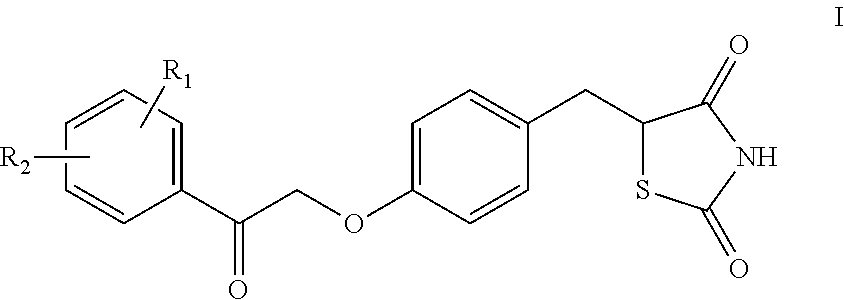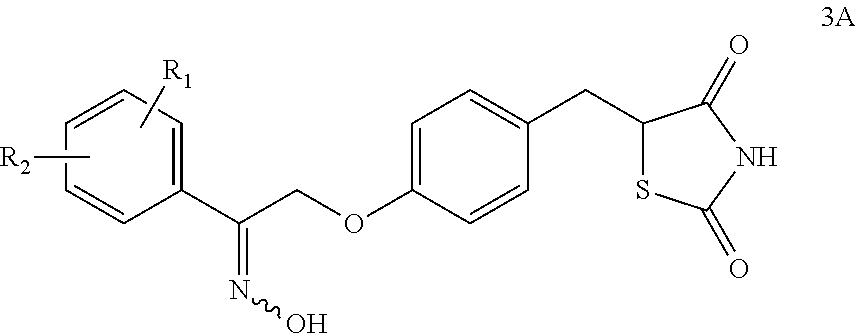Synthesis for thiazolidinedione compounds
a thiazolidinedione and compound technology, applied in the field of synthesis of thiazolidinedione compounds, can solve the problems of sodium reabsorption and other unpleasant side effects, and achieve the effects of reducing binding and activation of the nuclear transcription factor ppar, less cost of starting materials and process conditions, and safer and stabl
- Summary
- Abstract
- Description
- Claims
- Application Information
AI Technical Summary
Benefits of technology
Problems solved by technology
Method used
Image
Examples
example 1
Preparation of (Z)-5-(4-(2-(3-methoxyphenyl)-2-oxoethoxy)benzylidene)thiazolidine-2,4-dione
[0305]
[0306]To a stirring solution of 5-(4-hydroxybenzyl)thiazolidine-2,4-dione (100 mg, 0.4 mmol) in DMSO (2 ml), potassium tert-butoxide (106 mg, 0.941 mmol) was added. Stirring continued at RT for about 1 hour. 2-Bromo-3′-methoxyacetophenone (100 mg, 0.5 mmol) was then added to the mixture. After 2 hours, LCMS showed that the reaction was complete. The reaction mixture was partitioned between EtOAc and water, and the aqueous phase was extracted with EtOAc. Combined extracts were washed with brine, dried on (Na2SO4), filtered, and evaporated in vacuo. The residue was chromatographed on a small RediSep column eluting with 0-10% acetone / DCM. Fractions containing the product were combined and evaporated in vacuo to afford 70 mg of 5-{4-[2-(3-methoxyphenyl)-2-oxoethoxy]benzyl}-1,3-thiazolidine-2,4-dione as a pale yellow solid. 1H-NMR (DMSO-d6): δ 12.49 (brs, 1H), 7.72(s, 1H), 7.59(m, 1H), 7.53-7...
example 2
Preparation of (5Z)-5-(4-(2-(hydroxyimino)-2-(3-methoxyphenyl)ethoxy)benzylidene)thiazolidine-2,4-dione
[0307]
[0308]A stirring suspension of (5Z)-5-{4-[2-(3-methoxyphenyl)-2-oxoethoxy]benzylidene}-1,3-thiazolidine-2,4-dione (1.42 g, 3.84 mmol; Supplier=Kalexsyn; Lot=1003-TTP-149) in THF (15 ml) was heated with a heat gun—no solution. Added DMF (5 ml) and heated—no solution. Added another 5 ml DMF and heated until all solids dissolved. The hydroxylamine hydrochloride was added portionwise. Added HONH2.HCl (100 mg) and allowed to sit at RT overnight. HPLC showed a ratio of ca. 2:1 SM:pdt. Added 100 mg HONH2.HCl. After 4 hours there was little change in HPLC. Added 100 mg HONH2.HCl and left to stir over the weekend. The reaction was complete. The reaction mixture was partitioned between EtOAc (30 ml) and 1M KHSO4 (30 ml). The aqueous phase was extracted with EtOAc (30 ml). The combined organic phases were washed with saturated NaHCO3 (30 ml), brine (30 ml), dried (Na2SO4), filtered and ...
example 3
Preparation of 5-(4-(2-(hydroxyimino)-2-(3-methoxyphenyl)ethoxy)benzyl)thiazolidine-2,4-dione
[0309]
[0310]To a stirring suspension of (5Z)-5-(4-{[(2Z)-2-(hydroxyimino)-2-(3-methoxyphenyl)ethyl]oxy}benzylidene)-1,3-thiazolidine-2,4-dione (815 mg, 2.12 mmol) in THF / H2O (15 ml) was added cobalt chloride hexahydrate (2 mg) and 2,2′-bipyridine (8 mg). Stirred at RT for 10 minutes. Added NaBH4 portionwise until characteristic deep blue color was observed. When the color faded to give a yellow / orange solution, NaHBH4 was added portionwise until deep blue color persisted. Left to stir at RT overnight. The reaction was judged complete by HPLC. Adjusted pH to 6-7 with HOAc, then extracted with EtOAc (2×25 ml). The combined extracts were washed with brine, dried (Na2SO4), filtered and evaporated in vacuo to afford a 780 mg of a light yellow solid which was washed with DCM. 1H-NMR (DMSO-d6): δ 11.35(brs, 1H), 11.04(brs, 1H), 7.16 (m, 3H), 7.02(d, J=8.5 Hz, 2H), 6.80(m, 3H), 5.13(s, 2H), 4.33(dd,...
PUM
| Property | Measurement | Unit |
|---|---|---|
| temperature | aaaaa | aaaaa |
| affinity | aaaaa | aaaaa |
| aliphatic | aaaaa | aaaaa |
Abstract
Description
Claims
Application Information
 Login to View More
Login to View More - R&D
- Intellectual Property
- Life Sciences
- Materials
- Tech Scout
- Unparalleled Data Quality
- Higher Quality Content
- 60% Fewer Hallucinations
Browse by: Latest US Patents, China's latest patents, Technical Efficacy Thesaurus, Application Domain, Technology Topic, Popular Technical Reports.
© 2025 PatSnap. All rights reserved.Legal|Privacy policy|Modern Slavery Act Transparency Statement|Sitemap|About US| Contact US: help@patsnap.com



